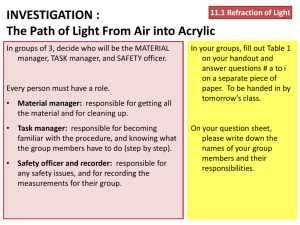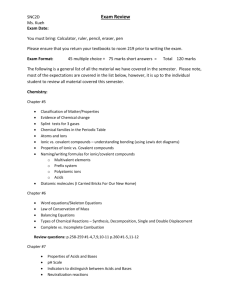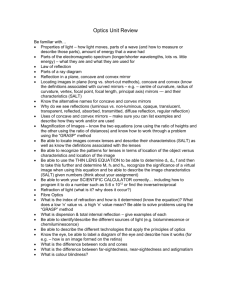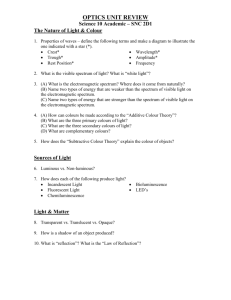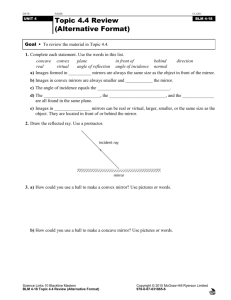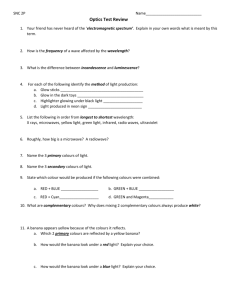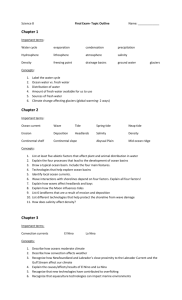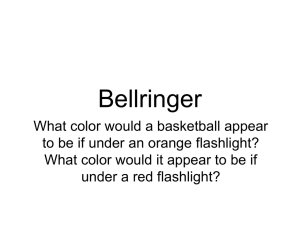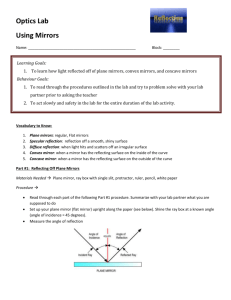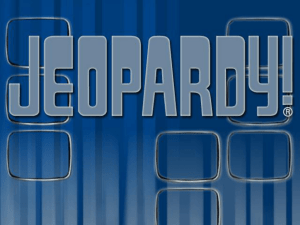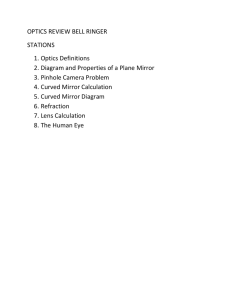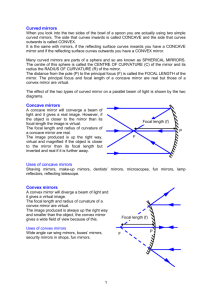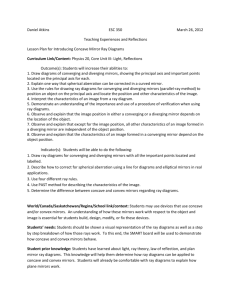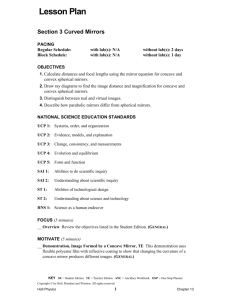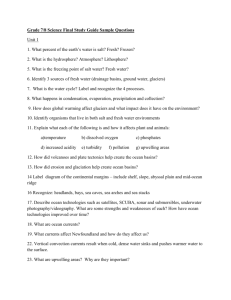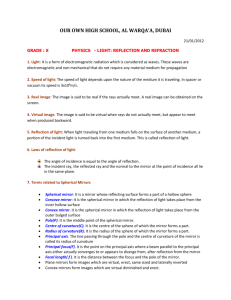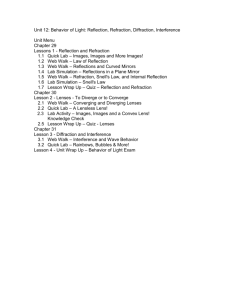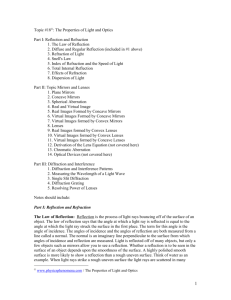17-SNC2D-SOLUTIONS
advertisement
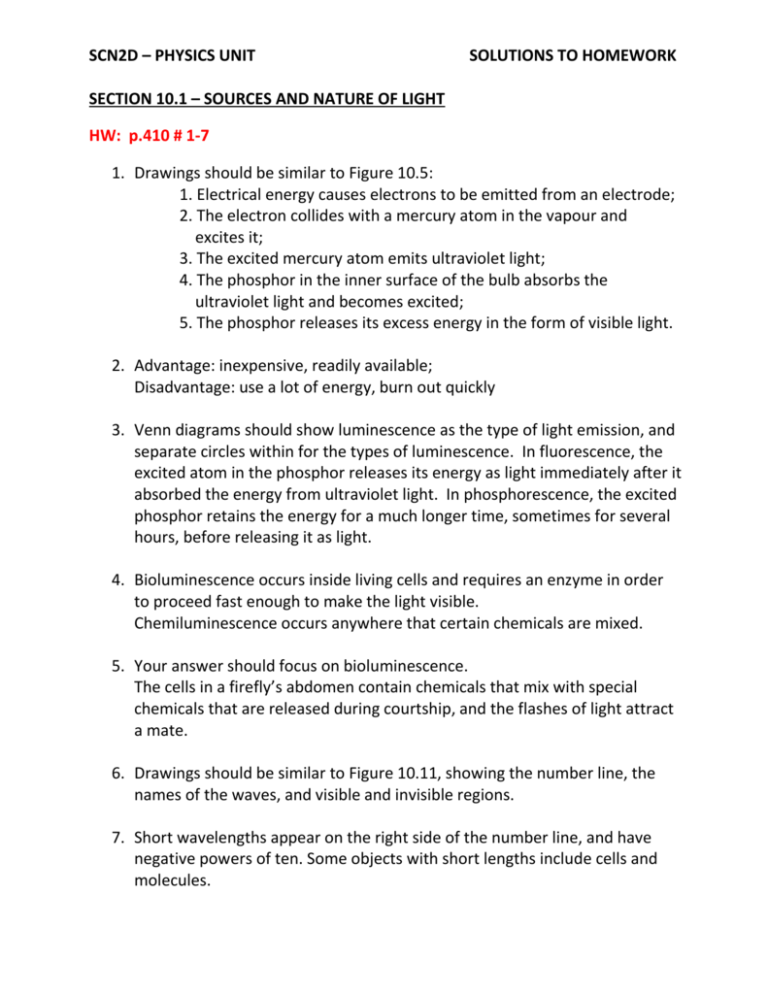
SCN2D – PHYSICS UNIT SOLUTIONS TO HOMEWORK SECTION 10.1 – SOURCES AND NATURE OF LIGHT HW: p.410 # 1-7 1. Drawings should be similar to Figure 10.5: 1. Electrical energy causes electrons to be emitted from an electrode; 2. The electron collides with a mercury atom in the vapour and excites it; 3. The excited mercury atom emits ultraviolet light; 4. The phosphor in the inner surface of the bulb absorbs the ultraviolet light and becomes excited; 5. The phosphor releases its excess energy in the form of visible light. 2. Advantage: inexpensive, readily available; Disadvantage: use a lot of energy, burn out quickly 3. Venn diagrams should show luminescence as the type of light emission, and separate circles within for the types of luminescence. In fluorescence, the excited atom in the phosphor releases its energy as light immediately after it absorbed the energy from ultraviolet light. In phosphorescence, the excited phosphor retains the energy for a much longer time, sometimes for several hours, before releasing it as light. 4. Bioluminescence occurs inside living cells and requires an enzyme in order to proceed fast enough to make the light visible. Chemiluminescence occurs anywhere that certain chemicals are mixed. 5. Your answer should focus on bioluminescence. The cells in a firefly’s abdomen contain chemicals that mix with special chemicals that are released during courtship, and the flashes of light attract a mate. 6. Drawings should be similar to Figure 10.11, showing the number line, the names of the waves, and visible and invisible regions. 7. Short wavelengths appear on the right side of the number line, and have negative powers of ten. Some objects with short lengths include cells and molecules. SCN2D – PHYSICS UNIT SOLUTIONS TO HOMEWORK SECTION 10.2 – PROPERTIES OF LIGHT AND REFLECTION HW: LEARNING CHECK p.414 # 2,3 2. Your diagrams should be similar to Figure 10.14, and it should show that ∠r = ∠i. 3. Your diagrams should be similar to Figure 10.14, where ∠i = 45° and ∠r = 45°. HW: p.418 # 1,2,4,6 1. (a) The incident ray is aimed perpendicular to the reflecting surface. (b) The angle of incidence is zero degrees. 2. image Size; image Attitude (orientation); image Location (distance); image Type (virtual or real) 4. The image distance is the distance between the mirror and the image. The object distance is the distance between the mirror and the object. 6. The image distance is the same as the object distance. The orientation of the image is the same as the orientation of the object, but the image is reversed (lateral inversion). The image size is the same as the object size. The type of image is a virtual image. SCN2D – PHYSICS UNIT SOLUTIONS TO HOMEWORK SECTION 10.3 – IMAGES IN CONCAVE MIRRORS HW: HANDOUT CONCAVE MIRRORS AND RAY DIAGRAMS CASE 1: CASE 3: CASE 4: CASE 5: SCN2D – PHYSICS UNIT SOLUTIONS TO HOMEWORK SECTION 10.4 – IMAGES IN CONVEX MIRRORS HW: LEARNING CHECK p.434 # 1, 3, 4 and “CURVED MIRROR” handout 1. Your Venn diagrams should show that both concave and convex mirrors have spherical shapes, but these types of mirrors are opposites. A convex mirror is shaped like the outside of a section of spherical surface, and the centre of a convex mirror protrudes outward from the edges. A concave mirror is shaped like the inside of a section of a spherical surface, and the centre of a concave mirror is indented relative to the edges. 3. Diagrams should be similar to the last diagram in Table 10.5. The image distance is smaller than the object distance. The image is smaller than the object. The orientation of the image is upright (the same as the object). The image is virtual. 4. Diagrams should be similar to the last diagram in Table 10.5. The image distance is smaller than the object distance. The image is smaller than the object. The image is upright. The image is virtual. SCN2D – PHYSICS UNIT SOLUTIONS TO HOMEWORK SECTION 11.1 – REFRACTION OF LIGHT HW: p.455 # 1-4 1. 1.82x108 m/s 2. 1.97x108 m/s 3. (a) 2.42 (b) Diamond 4. A. Diamond B. Flint C. Crown HW: p.456 # 1-8 1. Medium 1 is water and medium 2 is air since the ray is bent away from the normal in medium 2, it must be the less dense medium (air). 2. The index of refraction represents the ratio of the speed of light in a vacuum to the speed of light in a given medium. 3. 2.04 × 108 m/s 4. Temperature and pressure greatly affect the density of a gas, which determines its index of refraction. Thus, the index given is valid for the gas only under the stated conditions. 5. (a) A prism disperses white light into its component colours because each colour of light travels at a slightly different speed, and is thus refracted to a different degree within the prism. (b) Yellow light, because the angle of refraction is smaller for yellow light than for violet light, it must be travelling faster. 6. Since the index of refraction (n) is a ratio of the speed of light in a vacuum (c) over the speed of light in another medium (v), and nothing moves faster than the speed of light in a vacuum (c > v), then the value of n must always be greater than 1. 7. The angle of incidence must be zero (perpendicular to the boundary). The diagram should show light crossing the boundary between the two media at right angles, in which case there is no opportunity to deviate closer to or away from the normal. 8. Example: Shine a laser pointer into each sample. The block, which refracts the light more toward the normal, has the larger index of refraction (the flint glass). The diagram should show light shining into the glass blocks, redirecting closer to normal (perpendicular) in the flint sample than in the glass sample.
